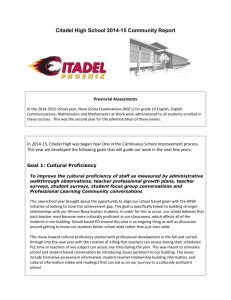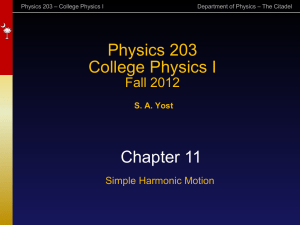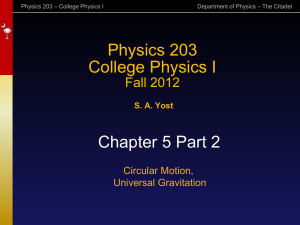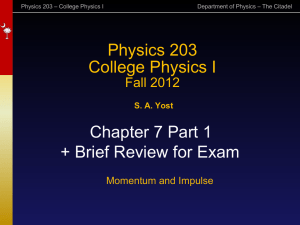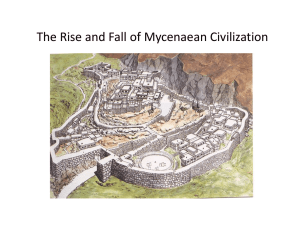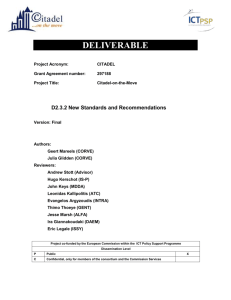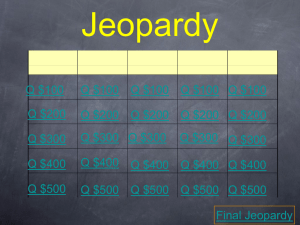Work and Kinetic Energy - The Citadel Physics Department
advertisement
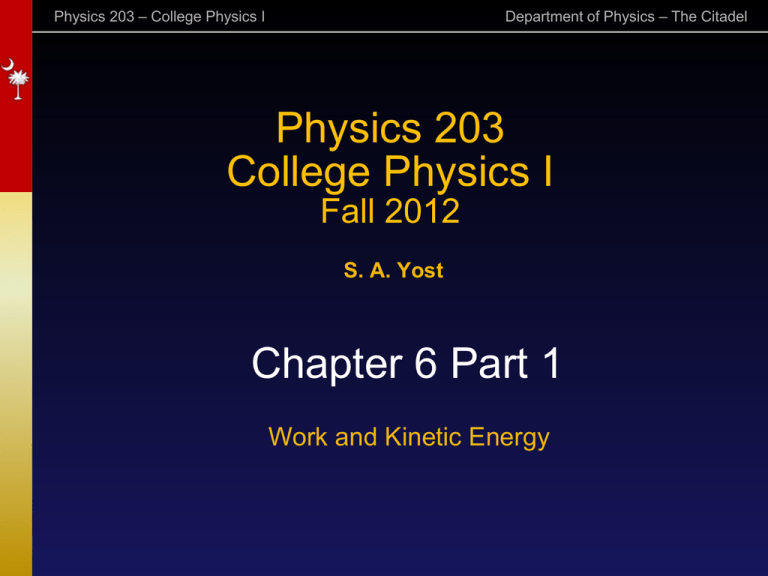
Physics 203 – College Physics I Department of Physics – The Citadel Physics 203 College Physics I Fall 2012 S. A. Yost Chapter 6 Part 1 Work and Kinetic Energy Physics 203 – College Physics I Department of Physics – The Citadel Announcements Read Chapter 6 for next time. You can skip sec. 6-2. Today we will discuss sec. 6.1, 6.3, and 6.10 on Work, Kinetic Energy, and Power. There is a problem set on these sections due Thursday: HW3A Next time, we will discuss sec. 6.4 – 6.9: Potential Energy, Energy Conservation, Non-Conservative Forces. Problem set HW3B is due next Tuesday. Physics 203 – College Physics I Department of Physics – The Citadel Newton’s Law and Orbits First: an orbit problem… Determine the mass of the sun using the properties of Earth’s orbit. (You can treat it as circular.) Newton’s Gravitational law: Newton’s 2nd Law: F = G Ms Me / R2. F = Mea = Mev2/R Uniform circular motion: v = 2pR / T G Ms Me / R2 = Me (2p/T)2 R Ms = (2p/T)2 R3 / G Physics 203 – College Physics I Department of Physics – The Citadel Newton’s Law and Orbits Ms = 4p2 R3/(GT2) R = 1.50 × 1011 m T = 1 year = 3.16 × 107 s G = 6.67 × 10–11 Nm2/kg2 The numbers give Ms = 2.00 × 1030 kg Physics 203 – College Physics I Department of Physics – The Citadel Effect of Force over Distance Applying a force to a particle over distance changes its speed in the direction of the force: vf2 – vi2 = 2ax (1 dim) Multiply by ½ m: ½ mvf2 – ½mvi2 = max Use F = ma: ½ mvf2 – ½ mvi2 = Fx Physics 203 – College Physics I Department of Physics – The Citadel The Work-Energy Theorem Definitions: Kinetic Energy = K = ½ mv2. Work = W = Fx. Units: Work = N m = Joules (J). Work-energy principle: The work done by the net force on a mass causes a change in kinetic energy: DK = W Physics 203 – College Physics I Department of Physics – The Citadel Work Requires Motion Work is done only when there is motion. W = Fx requires both F and x to be nonzero for W to be nonzero. You can push all day on a wall and get very tired, but if it doesn’t move, you did no work on it. F Physics 203 – College Physics I Department of Physics – The Citadel Question Suppose you apply a force Fp = 50 N to a box, which causes it to move at a constant speed through a distance of 10 m. What is the net work done on the box? A) 0.2 J B) 500 J C) 250 J D) 0 J Ff Fp = 50 N E) 5 J 10 m Physics 203 – College Physics I Department of Physics – The Citadel Example Suppose you apply a force Fp = 60 N to a box of mass m = 15 kg initially at rest, with coefficient of kinetic friction mk = 0.3. Two forces act on the box: Fp and Ff = mkmg. Fp Fp x Physics 203 – College Physics I Department of Physics – The Citadel Example 1. How much work do you do on the box when it moves a distance x = 12 m? You do an amount of work Wp = Fp x = (60 N)(12 m) = 720 Nm = 720 J Fp The pushing force is in the direction of motion, so the work is positive. x Physics 203 – College Physics I Department of Physics – The Citadel Example 2. How much work does friction do when you move the box 12 m? The force of friction is Ff = – mk mg = – (0.3)(15 kg)(9.8 m/s2) = –44 N The work done by friction is Fp Wf = Ff x = (–44 N)(12 m) = –528 J x Physics 203 – College Physics I Department of Physics – The Citadel Example 3. What is the kinetic energy of the box after being pushed 12 m? The box was initially at rest, so the kinetic energy is the net work, K = Wp + Wf = 720 J – 528 J = 192 J 4. What is the speed of the box after being pushed 12 m? The kinetic energy is K = ½ m v2 . v = √ 2 K/m = √ 2(192 J) / 15 kg = 5.1 m/s Physics 203 – College Physics I Department of Physics – The Citadel Orbit A satellite of weight mg is in a near-Earth circular orbit. How much work does gravity do on the satellite during each orbit? A) mgRe B) 2pmgRe Re C) 0 Think of the work-energy principle: DK = W. Physics 203 – College Physics I Department of Physics – The Citadel Work in More than 1 Dimension Only the component of force in the direction of motion does work. y W = (F cos q) x → F θ x A force perpendicular to the motion does no work! It can’t change the speed, so it doesn’t affect the kinetic energy. W = DK Physics 203 – College Physics I Department of Physics – The Citadel High Dive via Work/Energy v0 5.0 m A diver jumps with initial speed v0 = 1.4 m/s. At what speed does she enter the water 5.0 m below? Kf = K0 + W with K0 = ½ mv02, Kf = ½ mvf 2. Gravity is a constant force in the -y direction, so W = - mg Dy = mgh. The x motion does not affect the work. vf Physics 203 – College Physics I Department of Physics – The Citadel High Dive via Work/Energy v0 Kf = K0 + W 5.0 m ½ mvf2 = ½ mv02 + mgh vf = √v02 + 2gh v0 = 1.4 m/s, g = 9.8 m/s2, h = 5.0 m. vf = 10.0 m/s. vf Physics 203 – College Physics I Department of Physics – The Citadel Bowling Balls A ball-feeder lifts balls up a 1 m long ramp to a platform 0.5 m above the floor. How much force must the feeder arm exert to lift a ball weighing 50 N? 0.5 m Enter the answer in Newtons. Physics 203 – College Physics I Department of Physics – The Citadel Bowling Balls The feeder does work Wp = Fp L = F × 1.0 m. Gravity does work Wg = - mgh = -(50N)(0.5 m) = - 25 N Wp must be at least 25 J. 0.5 m Fp must be at least 25 N. Physics 203 – College Physics I Department of Physics – The Citadel Power Power is the rate of doing work: P = W/t. If the force F acts in the direction of motion, then P = Fv (instantaneous) These are consistent because x = v t is the distance traveled, so P = F v = F x/t = W/t. Physics 203 – College Physics I Department of Physics – The Citadel Bowling Balls If the ball feeder is powered by a 5 W motor, how many balls per minute can it lift, in continuous operation? 0.5 m Each ball required Wp = 25 J of work. The motor supplies (5 W) (60 s) = 300 J in a minute. That is enough energy to lift 12 balls. Physics 203 – College Physics I Department of Physics – The Citadel Pulleys How much force do I have to pull with to lift a block of mass M at a constant speed? Fp Solve it using work and energy. Physics 203 – College Physics I Department of Physics – The Citadel Pulleys Pulling a distance L with force Fp does work Wp = Fp L The block moves up a distance ½ L while lifted with a force FLift = Mg. Wp = FpL = WLift = ½ LMg Fp = ½ Mg Fp L ½L FLift Physics 203 – College Physics I Department of Physics – The Citadel Work by a Spring When a spring is compressed or stretched, there is a restoring force given by Hooke’s Law, F = – k x. k = spring constant. F L x x = -L x=0 Physics 203 – College Physics I Department of Physics – The Citadel Work by a Spring Suppose a ball is placed in front of the spring. If it is held at x = –L and then released, how much work does the spring do on the ball as it returns to its equilibrium position, launching the ball? m x = -L x=0 x Physics 203 – College Physics I Department of Physics – The Citadel Work by a Spring The work done by a changing force is the average force times the distance. F The force decreases from kL down to 0 linearly, kL so the average force is F = ½ kL. W=FL=½ W = ½ k L2 kL2. 0 -L 0 x Physics 203 – College Physics I Department of Physics – The Citadel Spring Gun Suppose a ball of mass m = 250 g is pushed back an distance L = 4 cm on a spring of spring constant k = 120 N/cm and released. m L How much work is needed to compress the spring? L = 0.040 m k = 12,000 N/m W = ½ kL2 = 9.60 J. Physics 203 – College Physics I Department of Physics – The Citadel Spring Gun When the spring is released, what is the launch speed of the ball? Work-Energy Theorem: K = ½ mv 2 = W = 9.60 J. m = 0.250 kg. v = √2K/m = 8.76 m/s. m v

